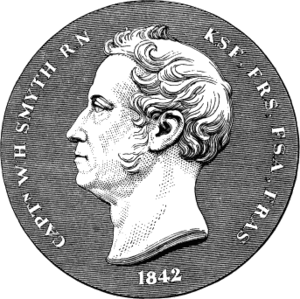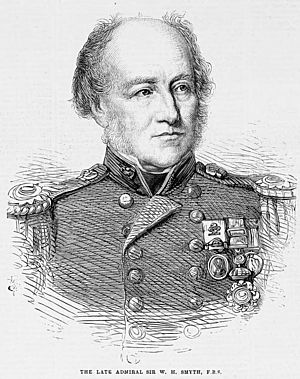William Henry Smyth facts for kids
Quick facts for kids
William Henry Smyth
|
|
|---|---|

Smyth, as depicted in his The Sailor's Word-Book
|
|
| Born | 21 January 1788 Westminster, London |
| Died | 8 September 1865 (aged 77) Stone, Buckinghamshire |
| Buried |
Stone, Buckinghamshire
|
| Allegiance | United Kingdom |
| Service/ |
Royal Navy |
| Years of service | 1804–1846 |
| Rank | Admiral |
| Commands held |
|
| Battles/wars | Napoleonic Wars |
| Awards | Order of Saint Ferdinand and of Merit |
| Spouse(s) | Eliza Anne "Annarella" Warington |
| Other work | Astronomer and numismatist |
Admiral William Henry Smyth (21 January 1788 – 8 September 1865) was a brave officer in the Royal Navy. He was also a talented hydrographer (someone who maps oceans and coasts), an astronomer (someone who studies stars and planets), and a numismatist (someone who collects and studies coins). He is remembered for his amazing maps, his work studying the night sky, and his many books. He also helped start several important scientific groups.
Contents
Early Life and Family
William Henry Smyth was born in London in 1788. He was the only son of Joseph Smyth and Georgiana Caroline Pitt Pilkington. Sadly, William never knew his father, who passed away the same year he was born. He grew up with his half-brother, Augustus Earle, and his half-sister, Phoebe Earle.
Later in life, some of William's family members made up stories about his ancestors. They even claimed he was related to famous people like Captain John Smith and Lord Nelson. However, these stories were not true.
When William was just 14 years old, he ran away from home and became a cabin boy on a merchant ship. This ship was later taken over by the Royal Navy, and William joined as an ordinary seaman. In 1804, he sailed on the Marquis Cornwallis, a ship chartered for an expedition. The Royal Navy later bought this ship and renamed it Cornwallis. William stayed with his captain, Charles James Johnston, and saw a lot of action in places like India, China, and the Pacific Ocean.
He later served on other ships, including Milford. During this time, he helped defend Cadiz in Spain from September 1810 to April 1811, even commanding a Spanish gunboat called Mors aut Gloria.
In 1813, at age 25, William was promoted to lieutenant. He joined the Sicilian fleet, where he fought against the French. He also secretly started mapping the coastlines and studying old ruins. For his service in defending Sicily, he received a special award called the Order of Saint Ferdinand and of Merit from the King of the Two Sicilies.

In 1815, William was promoted again to Commander. He took command of the brig Scylla and continued mapping the coasts of Sicily, Italy, and Africa. His mapping work became official in 1817 when he was appointed to Aid. This ship was later renamed Adventure. William created many detailed charts that the Royal Navy used for a long time, even into the mid-20th century! Because of his amazing work mapping the Mediterranean Sea, people started calling him "Mediterranean Smyth."
While in Sicily in 1817, he met a famous Italian astronomer named Giuseppe Piazzi. This meeting sparked William's interest in astronomy. He even named his second son, who also became a famous astronomer, Piazzi. William published some of his mapping work in books like Memoir description of the Resources, Inhabitants, and Hydrography of Sicily and its Islands (1824). Later, in 1854, he received the Royal Geographical Society's Founder's Medal for his important survey work.
In 1824, at age 36, William was promoted to Post-Captain. This was the end of his active service at sea. He then focused on his love for science and writing. He officially retired from the Navy in 1846 and continued to receive promotions on the retired list, eventually becoming a full Admiral in 1863 at the age of 75.
Studying the Stars
After leaving the sea, William settled in Bedford, England. In 1825, he set up his own private observatory at his home. He had a powerful telescope, nearly 6 inches wide, which he used to observe many different objects in space. He looked at double stars (two stars orbiting each other), star clusters (groups of stars), and nebulae (clouds of gas and dust in space).
In 1844, he published his observations in a book called Cycle of Celestial Objects. This book earned him the Gold Medal of the Royal Astronomical Society in 1845, and he even became the president of the society. The second part of his book, known as the Bedford Catalogue, contained his observations of 1,604 double stars and nebulae. This was a huge achievement because no astronomer had ever made such a detailed list of dim objects before. It became a very important reference book for many years.
One expert said that William's book was special because it was like a "celestial Baedeker" (a travel guide for the sky). He didn't just list numbers; he described what you would see through a small telescope and added interesting facts about astronomy, myths, and history.
After finishing his observations, William moved to Cardiff in 1839 to help build the Cardiff Docks. His observatory was taken apart, and his telescope was sold to another astronomer, Dr. John Lee. Dr. Lee set up the telescope again in a new observatory designed by William at Hartwell House. William moved nearby in 1842 and continued to use the telescope for more observations until 1859. Today, this historic telescope is at the Science Museum, London.
Coin Collector
William Henry Smyth was also very interested in coins. He was a founding member of the Royal Numismatic Society in 1836, which is a group for people who study coins. He wrote several books and papers about coins throughout his life.
Joining Scientific Groups
William was very active in the scientific community. In 1821, he became a member of the Society of Antiquaries of London (a group that studies history and old objects) and the Royal Astronomical Society. In 1826, he was elected a Fellow of the Royal Society, which is a very high honor for scientists. In 1830, he helped start the Royal Geographical Society (a group that studies geography and exploration).
He served as president of both the Royal Astronomical Society and the Royal Geographical Society. He was also a leader in many other scientific groups across Europe and the United States. He even served on the Board of Visitors for the Greenwich Observatory, a famous astronomical observatory.
Writing and Publications
William Henry Smyth wrote many important books and articles. Some of his most famous works include:
- A Cycle of Celestial Objects (1844): This two-volume work, which included The Bedford Catalogue, earned him the gold medal from the Royal Astronomical Society. It's still available today!
- The Mediterranean: a Memoir Physical, Historical, and Nautical (1854): This book shared his knowledge about the Mediterranean Sea. His maps from the 1820s were so good that the Royal Navy used them until the 1960s.
- The Sailor's Word-Book (first published in 1867): This is a huge dictionary of nautical terms. It covers words used on sailing ships and even early steamships. It's still available in print and as an e-book.
He also translated and edited books by the French astronomer François Arago about astronomy and comets.
Later Years and Legacy
William Henry Smyth had a home in Stone, Buckinghamshire, and another house in Chelsea, London. He used his London home to attend meetings of the scientific societies and to entertain his friends who shared his interests.
In September 1865, he had a heart attack. A few days later, on the evening of September 8th, he showed the planet Jupiter to his young grandson through a telescope. He passed away peacefully a few hours later, on September 9th, at the age of 78. He was buried in the churchyard of St John the Baptist church in Stone, Buckinghamshire.
People remembered him as a kind and cheerful person. His obituary in the Monthly Notices of the Royal Astronomical Society said he was always friendly and kept things happy, often using his humor to make sure everyone got along. It also mentioned that he would fill his pockets with new pennies to give to children he met on his walks.
To honor his contributions, a lunar mare (a large, dark plain on the Moon) was named Mare Smythii after him. The Smyth Channel in Chile and Cape Smyth in the Antarctic were also named in his honor.
Family Life
On October 7, 1815, in Messina, Italy, William married Eliza Anne ("Annarella") Warington. They were both 27 years old. Eliza was the only child of Thomas Warington, the British consul in Naples. William and Eliza had eleven children together. Five of their children became well-known or married notable people:
- Warington Wilkinson (1817–1890)
- Charles Piazzi (1819–1900)
- Henrietta Grace (1824–1914), who married Baden Powell and was the mother of nine children, including Robert Baden-Powell, 1st Baron Baden-Powell, who founded the Boy Scouts.
- Henry Augustus (1825–1906)
- Georgiana Rosetta (1835–1923), who married Sir William Henry Flower and had seven children, including Stanley Smyth Flower.
- Ellen Philadelphia Smyth (1828-1881), who married the meteorologist Captain Henry Toynbee (1819-1909).
Images for kids
-
The Great Comet of 1811, as drawn by William Henry Smyth




